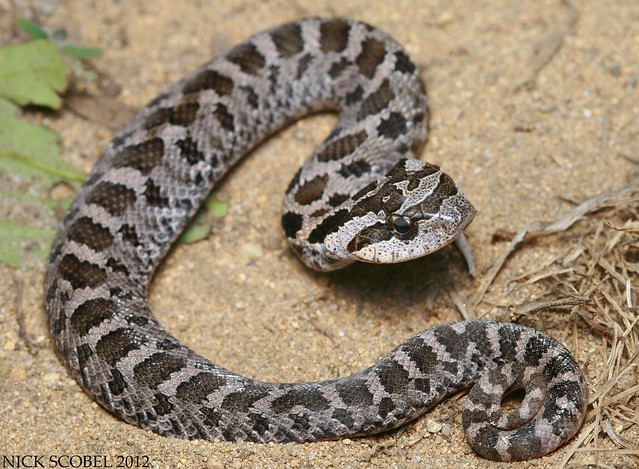Project Results
Last summer, we used Experiment to fund our current research project on diversity and habitat use of eastern hognose snakes. Our research examines how and why these snakes on a barrier island are different from those that live on the mainland. Typically, hognose snakes measure about 3 – 4 ft. long, but all of the snakes we have found on nearby barrier islands have been under 2 ft. — a phenomenon known as insular dwarfism.
Really cool things happen on islands, and even today we don’t know what’s going on. It seems every animal has a different way of adapting to an island. We have a pretty good idea that hognose snakes that live on barrier islands are smaller, but we don’t really know why. No one does, so we’re going to try to figure it out. The first step in answering this question is gathering enough data to confirm that there is a significant size difference.
About This Project
This video shows a large female Eastern Hognose Snake doing what they do best: NOT BITING, no matter what. I do not usually condone "messing" with animals, but in this case I think it is necessary to show people how docile and SAFE these snakes can be. Hognose snakes are COOL!Ask the Scientists
Join The DiscussionWhat is the context of this research?
Snakes are in a predicament: not only are they maligned by the general public, often cited as among the most feared and loathsome animals (Burghardt et al. 2009), but they also suffer from a lack of attention to population declines compared to other organisms (Meylan and Ehrenfeld 2000, Miller 2000, Norris 2007). In addition, snakes as a group are understudied, and we know little about the biology or ecology of most species (Dorcas and Wilson 2009), preventing the development of effective conservation measures. The Eastern Hognose Snake (Heterodon platirhinos), a species native to NY, and the subject of my research proposal, is a prime example of this predicament: the subject of loathing and apathy, confounded by sizable knowledge gaps.
Like many other snake species, the Eastern Hognose Snake is poorly studied across its range, but the few studies that have been conducted were focused on mainland populations; their ecology on barrier beaches has NEVER been formally studied, and therefore it is UNKNOWN how barrier beach populations of hognose snakes behave, utilize habitat, or how they survive on the few prey species available there. This information will be CRUCIAL to understanding how hognose snakes interact with their environment, which can aid CONSERVATION decisions and influence management actions on barrier beaches from Massachusetts to Florida.
Major research questions:
What habitats are hognose snakes using?
How far do hognose snakes travel?
Where do hognose snakes hibernate?
How close are they coming to the beach/ where people hang out?

What is the significance of this project?
Eastern Hognose Snakes are one of the most INNOCUOUS and CHARISMATIC snake species in North America, possessing an upturned rostral scale and exhibiting an extravagant death-feinting display when provoked (see video). However, despite their mild nature, hognose snakes have been subject to heavy persecution throughout their range, where locals often (erroneously) consider these snakes to be deadly, earning colloquial names such as “spreading viper” or “hissing adder.” Some people think these snakes spit venom, sting with their tail like a scorpion, or even possess a paralyzing glare! It is no surprise that human persecution is a large contributor to the decline of this species (Ernst and Ernst 2003).
Eastern Hognose Snakes are now considered a SPECIES OF REGIONAL CONCERN by both the Northeast Endangered Species and Wildlife Diversity Technical Committee (Therres et al. 1999) and Northeast Partners in Reptile and Amphibian Conservation (NEPARC 2010). In New York, hognose snakes are designated as “VULNERABLE” (Natureserve 2013), but do not currently receive habitat protection, although the New York State Department of Environmental Conservation (DEC) does list hognose snakes as a SPECIES OF SPECIAL CONCERN, a species in which "a welfare concern or risk of endangerment has been documented in New York State” (DEC 2007).
The health of the Eastern Hognose Snake population in Southern New York is poorly known. Despite once being widespread and so common that they could be literally collected by the barrel (Engelhardt 1915), the hognose snake was considered extinct on Long Island in 1996, until 2001 when a population was re-discovered at Brookhaven National Laboratory (Finn 2005). Subsequent isolated populations have been re-discovered across Long Island, but the DEC considers the hognose snake population on Long Island to be DECREASING (NYS DEC 2006).

What are the goals of the project?
For this study, I will radio-track Eastern Hognose Snakes and follow their movement patterns. Radio-tracking involves surgically implanting a small radio transmitter inside the abdomen of the snake, and subsequent re-finding the snake using a hand-held antenna and receiver. This procedure allows the researcher to gain insight into habitat utilization on a regular basis, and removes survey bias by allowing the animal to be found even when it would otherwise be hidden from view (in dense vegetation, underground, etc.). Don't worry, the snakes receive anesthesia and pain killers just like a person would during and after surgery.
The funding I am requesting is sufficient for FIVE radio transmitters made to order especially for this task and can only be purchased directly from the manufacturer. The company I ordered from, Holohil, is often considered an industry standard for radio-tracking snakes. My university already has an antenna and receiver, so I will not need to purchase these.
I have extensive experience radio tracking snakes and other animals, including rattlesnakes and black bears, and last year I carried out a similar project studying hognose snakes in upstate New York. Tracking animals requires practice and skill, so my past experiences will ensure successful completion of this project.
STEPS:
1) Survey study site and locate hognose snakes
2) Capture snakes and take them to The Bronx Zoo for surgical implantation of the radio-transmitters
3) Keep snakes in captivity until they recover from surgery
4) Release snakes at point of capture
5) Re-locate snakes on a regular basis
6) Use GPS data to model habitat use
7) Design management recommendations to advise land managers on the best ways to conserve hognose snakes
Budget
My budget is simple: all I would like (well, ok, need!) are radio-transmitters. The veterinarians at The Bronx Zoo will be donating their services for implantation surgery, and I already have most of the field equipment needed (and my University has what I do not). I hope to track as many snakes as I can, but I think 5 is a reasonable number of transmitters to ask for. Any extra support over the amount for 5 transmitters is greatly appreciated! Scientists love large sample sizes, but logistics often prevent this from happening in radio-telemetry studies.

Meet the Team
Affiliates
Team Bio
In addition to being a full-time graduate student at Hofstra, I work for the Cold Spring Harbor Fish Hatchery and Aquarium as an Environmental Educator, and for the Town of Hempstead as a Conservation Technician.I've been fortunate enough to work in a wide variety of places, and have radio-tracked black bears in the swamps of NC, fought wildfires in Florida scrub, trapped small mammals in the Adirondack Mountains, and tracked endangered Timber Rattlesnakes in Indiana.
As an undergrad at SUNY-ESF, I was the president of our student chapter of The Wildlife Society (TWS), and the captain of our NY and NE championship TWS Quiz bowl Team.
My broad interests include herpetological conservation, wildlife ecology, and animal behavior. On the side, I'm into birding, hiking, camping, and rough-housing with my Australian Cattle Dog, Carlin:

John Vanek
I'm currently the Postdoctoral Associate in Urban Wildlife Ecology and Evolution at Hobart & William Smith Colleges in Geneva, NY, and a Visiting Scholar at SUNY-ESF working on the SquirrelMapper project.
I earned my BS in Wildlife Science at the SUNY College of Environmental Science and Forestry, where I was president of our student chapter of TWS and captain of our quiz bowl team (Go Stumpies!). For my MS at Hofstra University, I studied the spatial ecology and biogeography of eastern hog-nosed snakes. For my PhD at Northern Illinois University, I partnered with the Lake County Forest Preserve District to better
understand the ecology, conservation and impacts of management of
wildlife in a suburban preserve district (from salamanders to
mesocarnivores).
During, after, and between my undergrad, masters, and PhD, I've been fortunate to have worked for the USFWS, USDA, the Cooperative Wildlife Research Laboratory,
consulting firms, various universities (Purdue, Florida State, Southern Illinois), and a municipal conservation department. I've worked with both game and non-game species, as well as in the control of nuisance species. I also spent two years as an environmental educator, which, although exhausting, was probably the most rewarding part of my career so far.
Additional Information
Fun Fact #1:Eastern Hognose Snakes are large, heavy bodied snakes, but they are NOT constrictors! Instead, they prey mostly on amphibians, with their favorite food being TOADS. Some people think hognose snakes pop toads to eat them, but this is just a myth.



Fun Fact #2:
People used to force feed snakes radio-transmitters! Thankfully, now we have developed much safer, humane ways to track snakes. Surgery might seem a bit excessive, but it has been shown to be an extremely safe procedure. Thanks to Mike Caldwell for this photo of a transmitter implanted in a Mohave rattlesnake (Crotalus scutulatus) . :

Fun Fact #3:
Eastern Hognose Snakes come in many colors, including nearly all black!



References:
Burghardt, G. M., Murphy, J. B., Chiszar, D., and Hutchings, Michael. (2009). Combating Ophiophobia: Origins, Treatment, Education, and Conservation Tools. In S. J. Mullin and Richard A. Seigel (Eds.), Snakes Ecology and Conservation (pp. 107-123). Ithica, NY: Cornell University Press.
Engelhardt, G. P., J. T. Nichols, Roy Latham, and R. C. Murphy. 1915. Long Island snakes. Copeia 17: 1-4.
New York State Department of Environmental Conservation. (August 8, 2007). List of Endangered Threatened and Special Concern Fish & Wildlife Species of New York State. In Animals, Plants, Aquatic Life. Retrieved Jan 10, 2013, from http://www.dec.ny.gov/animals/7494.html.
New York State Department of Environmental Conservation. (May 1, 2006). Appendix A4: Herpetofauna.In New York State Comprehensive Wildlife Conservation Strategy. Retrieved Jan 10, 2013, from http://www.dec.ny.gov/docs/wildlife_pdf/appendixa4.pdf.
Norris, S. (2007). Ghosts in our midst: coming to terms with amphibian extinctions. BioScience, 57(4), 311-316.
Finn, W. (2005). “Home Range and Spatial Ecology of Eastern Hognose Snakes (Heterodon platirhinos).” (Intern report, Brookhaven National Laboratory).
Gibbs, J. P., Whiteleather, K. K., & Schueler, F. W. (2005). Changes in frog and toad populations over 30 years in New York State. Ecological Applications,15(4), 1148-1157.
Gibbons, J., Scott, D., Ryan, T., Buhlmann, K., Tuberville, T.D., Metts, B.S., Greene, J.L., Mills, T.,Leiden, Y., Poppy, S., and C.T. Winne. 2000. The global decline of reptiles, déjà vu amphibians. BioScience 50: 653- 666
Miller, G. L. (2000). Nature's fading chorus: classic and contemporary writings on amphibians. Island Pr.
Natureserve. 2013. NatureServe Web Service. Arlington, VA. U.S.A. Available at http://services.natureserve.org. (Accessed: Jan 10, 2013)
Dorcas, M. E. and Willson, J. D. (2009). Innovative Methods for Studies of Snake Ecology and Conservation. In S. J. Mullin and Richard A. Seigel (Eds.), Snakes Ecology and Conservation (pp. 107-123). Ithica, NY: Cornell University Press.
Project Backers
- 20Backers
- 100%Funded
- $1,100Total Donations
- $55.00Average Donation
